Key Maintenance Tips for Your Home's Hot Water System
Key Maintenance Tips for Your Home's Hot Water System
Blog Article
What're your thoughts and feelings on How to Maintain a Hot Water Heater in a Few Simple Steps?

Warm water is necessary for everyday comfort, whether it's for a refreshing shower or washing meals. To ensure your warm water system runs successfully and lasts longer, regular maintenance is vital. This write-up provides sensible ideas and insights on just how to preserve your home's hot water system to prevent disruptions and pricey repair work.
Intro
Preserving your home's hot water system may appear challenging, yet with a few straightforward steps, you can ensure it runs efficiently for several years ahead. This overview covers whatever from recognizing your hot water system to do it yourself upkeep suggestions and recognizing when to contact professional assistance.
Importance of Preserving Your Hot Water System
Routine maintenance not only expands the lifespan of your warm water system but likewise ensures it operates successfully. Overlooking upkeep can lead to reduced performance, higher power bills, and even early failure of the system.
Indications Your Warm Water System Needs Upkeep
Recognizing when your hot water system requires focus can prevent major concerns. Keep an eye out for indications such as irregular water temperature, odd sounds from the heater, or rustic water.
Recognizing Your Warm Water System
Before diving right into upkeep jobs, it's useful to comprehend the standard parts of your hot water system. Normally, this includes the water heater itself, pipes, anode rods, and temperature level controls.
Month-to-month Upkeep Tasks
Regular regular monthly checks can assist capture small concerns prior to they escalate.
Flushing the Water Heater
Purging your water heater removes debris buildup, enhancing effectiveness and extending its life.
Checking and Replacing Anode Rods
Anode rods stop rust inside the tank. Examining and replacing them when worn is vital.
Evaluating and Readjusting Temperature Level Setups
Readjusting the temperature settings ensures optimal efficiency and safety and security.
Do It Yourself Tips for Upkeep
You can execute several maintenance jobs on your own to maintain your warm water system in top condition.
Checking for Leaks
Frequently examine pipes and connections for leakages, as these can bring about water damages and higher bills.
Testing Stress Alleviation Valves
Checking the pressure relief valve ensures it operates appropriately and stops extreme pressure build-up.
Protecting Pipes
Insulating warm water pipelines decreases heat loss and can conserve power.
When to Call a Specialist
While DIY maintenance is valuable, some problems require specialist experience.
Complex Concerns Needing Professional Help
Instances include significant leakages, electric troubles, or if your water heater is regularly underperforming.
Regular Specialist Upkeep Conveniences
Expert upkeep can include thorough assessments, tune-ups, and guaranteeing conformity with security requirements.
Conclusion
Routine maintenance of your home's warm water system is essential for effectiveness, longevity, and expense financial savings. By following these ideas and knowing when to look for specialist assistance, you can make certain a reputable supply of hot water without unanticipated interruptions.
How to Maintain an Instant Hot Water Heater
Before tinkering with your hot water heater, make sure that it’s not powered on. You also have to turn off the main circuit breaker and shut off the main gas line to prevent accidents. Also turn off the water valves connected to your unit to prevent water from flowing into and out of the appliance. 2. When you’re done, you have to detach the purge valves’ caps. These look like the letter “T†and are situated on either side of the water valves. Doing so will release any pressure that has accumulated inside the valves while at the same time avoid hot water from shooting out and burning your skin. 3. When the purge valves’ caps are removed, you have to connect your hosing lines to the valves. Your unit should have come with three hoses but if it didn’t, you can purchase these things from any hardware or home repair shops. You can also get them from retail stores that sell water heating systems. Read the user’s manual and follow it to complete this task properly. When the hosing lines are connected, open the purge port’s valves. 4. You should never use harsh chemical cleaners or solutions when cleaning your unit. Make use of white vinegar instead. It should be undiluted and you’ll probably use about 2 gallons. 5. Now flush your water heater. This task should probably take about 40 minutes. We can’t give you specific directions for this because the procedure is carried out depending on the type, model and brand of your heater. With that being said, refer to the user’s manual. 6. When you’re done draining the unit, you have to turn off the purge port valves again. Remove the hosing lines that you earlier installed on each of the water valves. Put the valve caps (purge port) back in their respective places and be very careful so as not to damage the rubber discs that are found inside these caps. 7. Now that everything’s back in place, check your user’s manual again to find out how to reactivate your water heating system. 8. Once it is working, turn one of your hot water faucets on just to let air pass through the heater’s water supply pipes. Leave the tap on until water flows smoothly out of it. https://www.orrplumbing.com/blog/2014/september/how-to-maintain-an-instant-hot-water-heater/

We were guided to that report on What Kind of Maintenance Do Water Heaters Need? from a buddy on our other domain. Liked our entry? Please share it. Help others discover it. Thanks a lot for your time. Kindly visit our site back soon.
Go Company Report this page